Summer 2024
2 Situation report | 4 ‘All doctors to the emergency room!’ Dr Chris Hook reports from Gaza. 6 In the eye of the storm Ten years on from the West Africa Ebola outbreak, a new book takes the reader to the frontline of MSF’s epidemic response. | 10 Emergency solar unit See how MSF powers its medical work in deserts, conflict zones and remote regions. | 12 Whatever it takes Join an MSF mobile team in South Sudan as they travel deep into the bush to provide medical care to semi-nomadic cattle herders.

113
SITUATION REPORT
40%
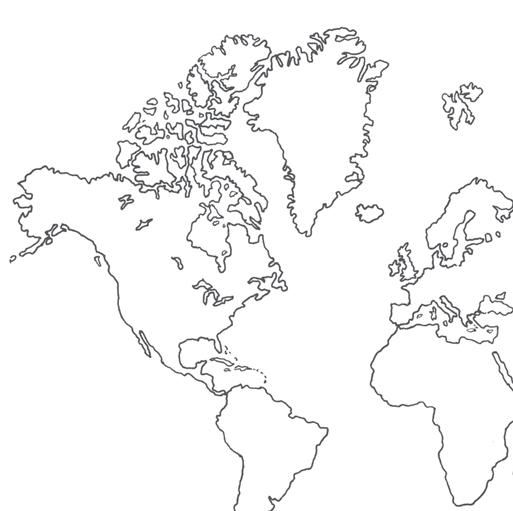
Increase in cholera cases worldwide from 2022 to 2023

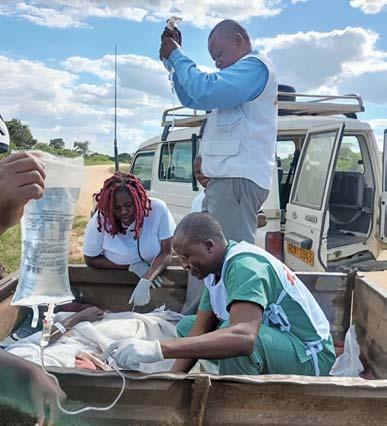
1. ZIMBABWE
MSF staff rehydrate a cholera patient in a horse-drawn cart by the roadside. Zimbabwe is currently grappling with the second largest cholera outbreak in its history, with more than 3,500 people infected and 600 deaths to date. Spread by contaminated water, this cholera outbreak has been compounded by the country’s dilapidated water and sewage systems. MSF teams are treating patients in various locations across Zimbabwe.

2. ABYEI SPECIAL ADMINISTRATIVE AREA
An MSF team member greets a woman at a health post in Nyinijo village on the banks of the river Kiir. MSF manages 17 health posts spread out across this region, many of which can only be reached on foot during the rainy season. Villagers live in constant fear of violence, exacerbated by the conflict in Sudan and instability in South Sudan, both of which lay claim to the area. In various locations across Abyei, MSF teams provide around-the-clock emergency treatment, surgery, inpatient care, maternal and neonatal care, treatment for chronic illnesses and mental health support.

2 | DISPATCHES 4 6 3 5 2
1
© MSF
Photograph
Photograph © Sean Sutton/Panos Pictures

3. NIGERIA
Khadijah is a traditional birth attendant in Aujara village in Jigawa state, where more than 80 per cent of births take place at home. Since 2008, MSF has been providing maternal healthcare in the region and supporting traditional birth attendants to help women give birth safely.
22,800
People treated for trauma injuries by MSF teams in Sudan since April 2023

4. SUDAN
Khadija Mohammad Abakkar holds her child in Zalingei hospital, Central Darfur state. Sudan has been embroiled in a brutal conflict for more than a year, forcing more than six million people to leave their homes. “Sudan is one of the worst crises the world has seen for decades,” says MSF international president Dr Christos Christou. “There are extreme levels of suffering across the country, the needs are growing by the day, but the humanitarian response is deeply inadequate.” MSF teams are currently working in 13 states in Sudan providing emergency medical care, surgery, and water and sanitation services.
5. DEMOCRATIC REPUBLIC OF CONGO
Francine and Jean-de-Dieu play with their three-month-old son Amini Naël in their shelter in Kanyaruchinya camp near Goma, the capital of North Kivu province. Since 2022, more than one million people have fled their homes to escape fighting in the province. Most have sought refuge near Goma, where they live in desperate conditions in improvised camps, without enough clean water, food or healthcare, and with no protection from violence, including sexual violence, which has reached epidemic proportions in and around the camps. MSF runs a health centre in Kanyaruchinya camp where teams treat around 250 patients every day.

6. HAITI
Local residents use a wheelbarrow to move their belongings in the aftermath of fighting between armed groups and the police in the Delmas 18 neighbourhood of Port-au-Prince. Extreme violence has gripped the capital since February, with street battles, crossfire and widespread looting. Healthcare services in the capital are under severe pressure, with some hospitals no longer functioning and others overwhelmed. MSF has started to run mobile clinics to take medical care to residents trapped in their neighbourhoods by the violence.

SUMMER 2024 | 3
Photograph ©
Philémon Barbier
Photograph © Abba Adamu Musa/MSF Photograph © Corentin Fohlen/Divergence Photograph © MSF

GAZA EMERGENCY
‘All
doctors to the emergency room!’

OVERWHELMED WARDS, DIFFICULT DECISIONS AND INSPIRING ACTIONS. DR CHRIS HOOK RETURNS FROM GAZA, WHERE HE JOINED TEAMS WORKING UNDER EXTREME PRESSURE TO PROVIDE LIFESAVING CARE.
When we arrived in Gaza we went straight to Nasser hospital, in Khan Younis. Overwhelming numbers of patients with severe burns and traumatic injuries were arriving regularly at the hospital. Some came in trucks with seven or eight people loaded in the back, some of them injured, some already dead. Others were brought in by their families, rushed in from cars or carried by brave bystanders determined to help.
MASS CASUALTY INCIDENTS
‘All doctors to the emergency room!’
The room is immediately full of people. There aren’t enough beds, so patients are treated on the floor, which quickly becomes covered in blood. Sometimes there aren’t enough medications. Amid the crowds, doctors make incredibly difficult decisions about who to treat with the resources available. There’s no quiet space to take people whose injuries are not survivable, nowhere to gently explain to their families what is happening.
I remember one girl in particular, around 11 years old. There had been a direct hit on her house but somehow she had been pulled out of the rubble. None of her family had survived.
MSF water and sanitation agent Youssef Al-Khishawi helps distribute clean drinking water to displaced Palestinians sheltering in the town of Rafah in south Gaza.
Photograph © MSF
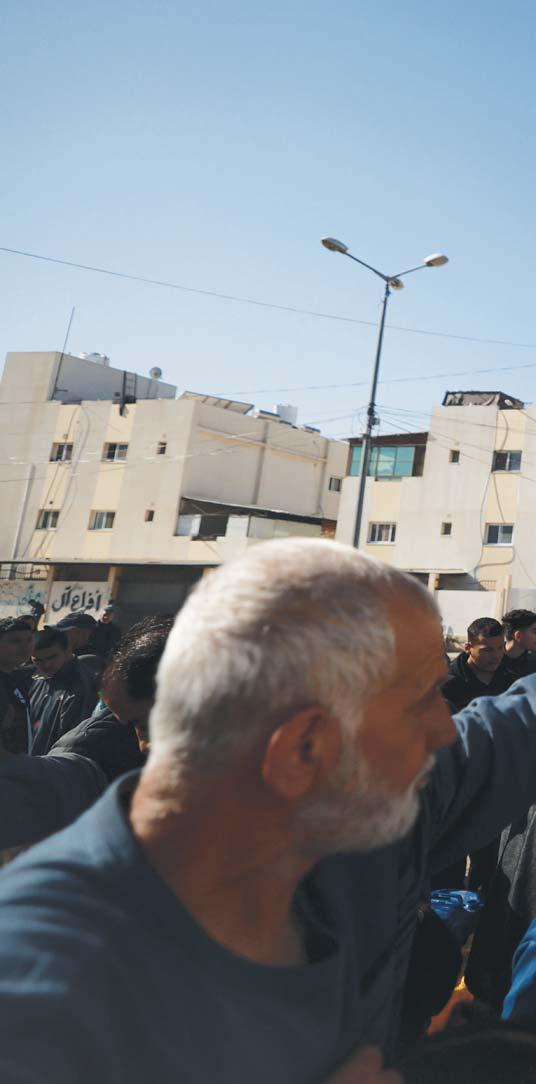
She had extensive injuries, but the team managed to resuscitate her. A CT scan showed she had severe lung contusions – bruising caused by blunt force to the chest that causes blood and other fluid to build up around the lungs and can stop them functioning. Thankfully the ICU team were able to stabilise her and put her on a ventilator to help her breathe.
She also had several large wounds, extensive burns and a broken leg. It’s hard to imagine the pain and fear she must have experienced. She needed plastic surgery, orthopaedic surgery and skin grafts – a huge amount of surgery for anyone, but especially for a child on her own.
DOING WHAT WE CAN
The security situation in Gaza and the lack of humanitarian access means that MSF is not able to work as we normally would. In these circumstances, it’s important to focus on what we can achieve.
In the three weeks that our surgery project was operational, the hospital went from carrying out around eight surgeries a day to more than 20.
4 | DISPATCHES
GAZA
MSF
PHOTOGRAPHY

The fact that medical care is functioning at all in Gaza is thanks to our Gazan colleagues. Some have escaped bombing in three or four different cities, trying each time to find somewhere safe for their families. But when we opened a new field hospital in Rafah, there they were, asking: ‘What can we do? How can we help?’
Most have lost family members, most have lost their homes. They worry about their families every time they leave to come to work.
But they keep turning up and they keep treating patients, even when there is a threat to their own lives. And they find moments of humour and positivity among it all. The situation in Gaza is brutal, but what Gazan health workers are doing is one of the most inspiring things I have ever witnessed.
AN UNCERTAIN FUTURE
After she’d been in hospital for around five days, the little girl’s extended family found her. They had heard that someone might have survived the
shelling and they had started to search. She recovered well from the surgeries and we were able to discharge her to their care with an external fixator – a metal frame holding her fractured bone in place – on her lower leg.
We don’t know what will happen to her next. The area around Nasser hospital has been declared an ‘evacuation zone’, meaning that everyone has been ordered to leave. Her external fixator will be a risk for infection unless she’s able to access appropriate follow-up care.
This is the third time I have worked in Gaza. On those earlier postings, I saw the high-quality care the medical teams were providing and how much it was needed. Now those teams are stretched beyond the limit.”
Nasser hospital was forced to close on 18 February 2024. MSF continues to work in two hospitals in Gaza and provides support to a number of health posts.
SUMMER 2024 | 5
READ THE LATEST UPDATES AT MSF.ORG.UK
 An MSF health worker dons full PPE before entering an Ebola treatment centre in the Liberian capital, Monrovia, 30 August 2014. Photograph © Morgana Wingard
An MSF health worker dons full PPE before entering an Ebola treatment centre in the Liberian capital, Monrovia, 30 August 2014. Photograph © Morgana Wingard


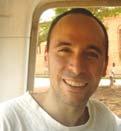
SIERRA LEONE PHOTOGRAPHY MSF
TEN YEARS AGO, ON 23 MARCH 2014, GUINEA DECLARED AN OUTBREAK OF EBOLA. EBOLA OUTBREAKS WERE KNOWN TO BE DANGEROUS, BUT ALSO SMALL. BUT NOT THIS TIME: IT WOULD TAKE TWO YEARS, AND MORE THAN 11,000 DEATHS IN GUINEA, LIBERIA AND SIERRA LEONE, BEFORE THE EPIDEMIC WAS OVER. IN THIS EXTRACT FROM HIS NEW BOOK, MSF’S DR BENJAMIN BLACK RECOUNTS BEING AT THE FOREFRONT OF AN UNFOLDING EPIDEMIC.
IN THE EYE OF THE STORM
GONDAMA, SIERRA LEONE, JULY 2014
“The woman is lying on the floor outside the maternity department; her large pregnant belly slopes to one side as her back arches, face muscles clench and a violent, jerking convulsion resumes. It’s past midnight, the air is warm and humid, hanging heavily around us. The two men who had squeezed her on to the back of their motorbike stand silently staring; everyone is staring.
If this is an eclamptic seizure, her life, and that of her unborn child, can be saved. Take her inside the hospital, begin treatment and deliver the baby. The husband is watching us with red, pleading eyes. Every day, women come with emergencies; they come to us trusting we will treat them. But now we stand, frozen, contemplating the woman and the life lying on the floor in front of us.
Blood is round her nose and mouth. ‘She fell forward on to her face with the first seizure,’ says the weary looking husband. Around the world, a woman dies every two minutes from a pregnancy-related complication, eclampsia being one of the leading causes. Virtually all maternal deaths are preventable. It is the reason we are here, and why she has come to us. Her death will be tragic, not only for herself and her children, but for her whole community. It will mean the loss of all the functions she, as a woman, brings to society.
…The seizure stops, her arms flop to her sides and her chest rises with rapid shallow breathing. ‘What is your address?’ A nurse in green scrubs shouts from several metres distance to the husband. Small beads
SUMMER 2024 | 7
of sweat shine on her forehead, reflecting the headlight of the motorbike. They have travelled far. Their journey began in a town six hours away – a town with a recent cluster of Ebola cases. If this is Ebola, it changes everything.
Ebola strikes fear into the public and healthcare workers alike.…The disease spreads efficiently from person to person via infected body fluids. The incubation period is thought to last up to 21 days. Initial symptoms are general and non-specific: a fever, aching joints, weakness. Similar to other common ailments, such as malaria or influenza, it is easily missed. The virus infects the cells lining our blood vessels, organs and intestines. As our immune system tackles the onslaught, our body becomes the battlefield. Blood leaks from the vessels. Bowels seep fluid. Inflamed organs become painful and dysfunctional. The virus is deadly, but so too is the body’s counter-attack, destroying itself in the effort to purge the invader. Over time, the condition develops into more severe vomiting and diarrhoea, which can progress to multiple organ failure and death.
As disease severity worsens, the infected person becomes increasingly contagious. By the time of death, their body is encased in their virus-packed excretions of urine, faeces and sweat. Those caring for the sick, offering comfort and washing their bodies, tread a perilous path. The risk of infection for healthcare workers in West Africa was up to 32 times greater than it was for the general public.
Her husband is becoming anxious. Why the questions? Why are we not rushing to save his wife and child? He gently places a folded cloth under her head and strokes her face. He brought her to us for help. Her situation is desperate. All he sees are the silhouettes of nurses, midwives and a doctor, conspiratorial and whispering.
With only one capable laboratory in the country, it will take over 24 hours for an Ebola test result to be returned. Without treatment for her pregnancy complications, she will die. Inside, there are tight rows of women sleeping under mosquito nets, next to babies bundled in brightly patterned lappa. In the daytime, breast milk, blood, sweat and soiled bedclothes mix as the women congregate, sharing advice, joy and condolences.
…A light breeze momentarily breaks the tension. The triage paper used for checking Ebola symptoms has become soft with the rainy season’s moisture. Glances pass from one person to another, piercing through the night air. The woman lies unconscious. Should she come inside maternity, or stay outside? Eclampsia or Ebola? If the diagnosis is incorrect, by the time it is realised, the damage will be done.
The epidemic was out of control. Every day, we were receiving more patients. They were arriving from increasingly far away, meaning longer journeys squeezed in the back of ambulances, bouncing along those terrible roads. By the time the ambulances arrived, we would find patients who had died en route, and patients lying, dazed, next to them, disorientated and dehydrated.
We took turns to run around to the ambulance bay, assessing the condition of the people in the back of the vehicles. Standing a couple of metres away, we would shout to the passengers inside, ‘Open the window! How many of you are there?’
We tiptoed to see through the crack of the ambulance window. Trying to count patients and see if anyone was on the floor. Conferring with one another what our next step should be.
The ambulance drivers often did not know themselves what or who they were bringing. They

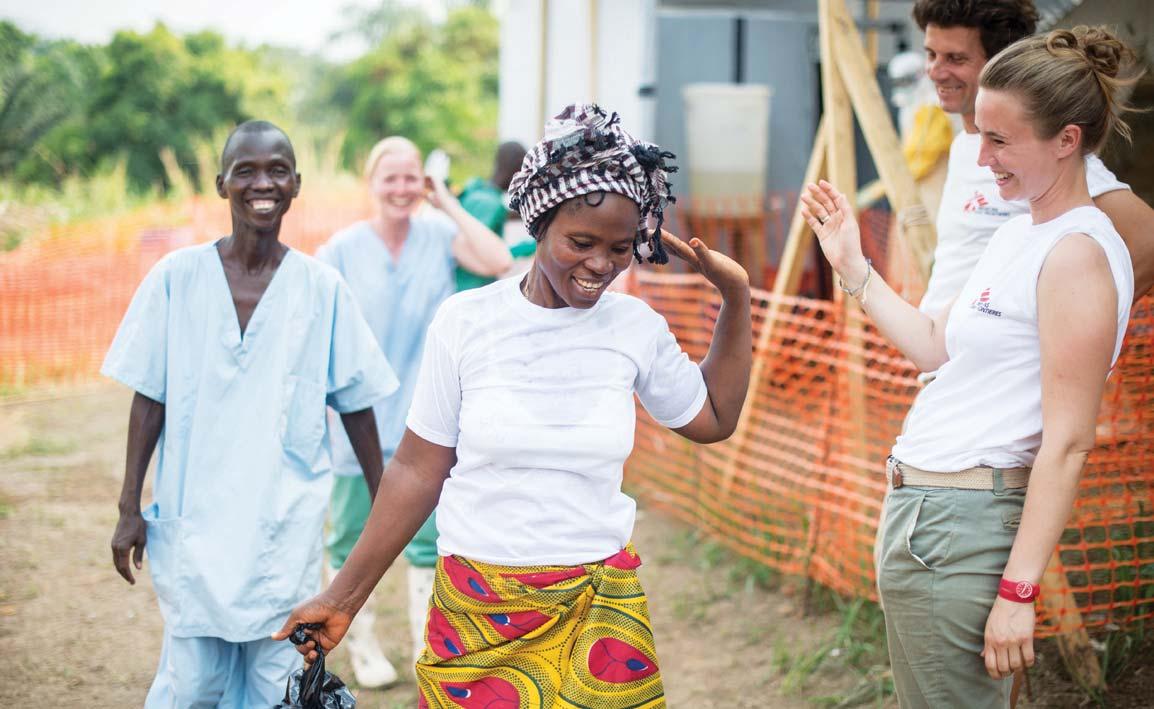 Sia Bintou leaves MSF’s Ebola treatment centre in Guéckédou, Guinea, after recovering from the disease, 19 April 2014. Photograph © Sylvain Cherkaoui/ Cosmos
Sia Bintou leaves MSF’s Ebola treatment centre in Guéckédou, Guinea, after recovering from the disease, 19 April 2014. Photograph © Sylvain Cherkaoui/ Cosmos

were unsung heroes, providing a vital service. Transporting infected people was a hazardous job. I do not know how many of those drivers became infected; I do remember those dark days when we would isolate familiar faces: soldiers from the front line. Incredibly, there were drivers who, having survived Ebola and witnessed all that death inside the Ebola treatment centre (ETC), went back to continue their essential work, showing a strength that does not exist in many people. Those drivers saved uncountable lives.
Looking back now, I realise I did not appreciate the drivers and the work they did. They all wore some form of PPE – terrified, I assume, of getting infected and taking the disease home to their families. They would be drenched in sweat, having driven in the impermeable suits. We would give them bottles of water to rehydrate and, once the patients (alive and dead) were unloaded, the ambulance would be sprayed inside and out with chlorine to decontaminate it.
On instruction, and quite sensibly, we would not touch anything from the ambulance. The referral papers for patients coming from other hospitals would be held only in gloves and read out to someone else to copy the information down. The driver, their ambulance and all that was in it represented an Ebola twilight zone. They were neither infected nor free of the risk of onwards transmission, and yet they were fundamental to the fight.
Those final weeks of August are a time I see like a film. I’m not there, I’m watching it all play out on screen. The ETC had been expanded twice to meet the needs of increasing patient numbers, and still we were struggling. There were now 80 beds, and it was not enough.
I would often go in the early hours of the morning to collect blood samples and insert IV lines. During those morning rounds, we also took note of which
patients had not survived the night. There were so many patients coming in and out, we relied on their numbers to identify them and to know where in the ETC they were located. They represented bed spaces we could empty for the next round of sad and confused souls to arrive.
We were witnessing death on a scale no person or people should ever experience. The young, the old, those in the prime of life, stronger and fitter than I will ever be, bent and bleeding, begging for help, while lying curled in their own uncontrolled vomit and excrement. Often, a person would die with their back painfully arched and limbs upright and flexed – the typical position of a person who has died from their brain swelling. Rigor mortis would freeze them, like a statue from a Greek tragedy. Their twisted form caused great difficulty when laying them to rest in the body bag.
Death became so familiar it was a passing comment, a matter of fact. ‘Thirty-one, 35 and 40 are dead; we’ll need one child and two adult body bags.’ I am chilled to think how those words rolled so easily off my tongue. It was just work. We had to get the dead out to get more living in, and so the wheel turned.
It is hard to convey humanity in an Ebola isolation unit. As a health worker, I am used to reaching out and touching my patients, letting them know they are not alone. In the ETC, any contact was through double gloves and triple-layered protective clothing. My eyes were the only part of me visible, behind their misted goggles and the small slit in my head dress. The distance created by the PPE was compounded by the linguistic and cultural differences, and the lack of understanding about Ebola. I have never felt so far removed from and, at the same time, so intimately close to a stranger, as when I rested my gloved hand on Mariama’s, and, with only my eyes and the subtle movement of my head, conveyed my deepest sympathies.
Regretfully, I learnt to develop this communication, repeating it several times during those few days in Kailahun.
Despite the unfortunate and frightening circumstances, a community had developed among the patients in the isolation unit. They would sit together outside the tents around the ‘confirmed’ area, listening to a radio or chatting in small circles. A group of children, who were doing surprisingly well inside the ETC, had come together to create a pseudo-family, the older kids caring loyally for the younger ones, offering a stark sign of hope during difficult times.”

Belly Woman: Birth, Blood & Ebola – The Untold Story by Benjamin Black is published by Neem Tree Press and is available now.
SUMMER 2024 | 9
MSF staff prepare food for patients at Kailahun Ebola treatment centre in Sierra Leone, 27 August 2014. Photograph © P.K. Lee/MSF
EMERGENCY SOLAR UNIT
GETTING HOLD OF FUEL IN REMOTE LOCATIONS OR DURING EMERGENCIES CAN BE A MAJOR CHALLENGE FOR MSF MEDICAL TEAMS.
In places where there is no electricity, MSF typically relies on diesel generators, but it can be difficult, costly and sometimes dangerous to transport the fuel to run these generators. And because fossil fuels cause carbon emissions, the environmental footprint of transporting fuel and running a diesel generator is far from ideal.
In their quest for a solution, MSF logisticians have been trialling an innovative mobile solar unit, in the form of a container with extendable solar panels. The solar panels have a total surface area of 150m² and can produce up to 60kWh – enough electricity, in theory, to run an entire health centre or vaccination clinic. Tents can be set up underneath the solar panels so that the structure functions as a portable health centre.
“We wanted to find something that we could deploy and redeploy at will,” says MSF logistician Daniel Mangel. “It only needs a small team of around four to six people to set it up, and it can be unloaded and in place in approximately three hours.”
Importantly, installing this all-in-one setup can be done without an electrician, which eliminates the problem of finding trained technicians in remote locations.
The solar unit is currently being tested in Ourang, eastern Chad, where MSF teams are providing medical care to 50,000 refugees who fled the conflict in neighbouring Sudan. Running alongside a traditional diesel generator, the solar unit provides the energy needed to run various medical activities and has considerably reduced the project’s fuel consumption.






























































CONTROL CENTRE



























Contains digital control units, electrical system and batteries, in a sealed-off and air-conditioned enclosure. “We have gone with lithium batteries rather than sodium,” says Daniel Mangel. “Lithium batteries have higher energy densities which means they can store more energy and have a longer life.”
To get the unit to Ourang, MSF transported it via sea from the Port of Bordeaux, in France, to Doula, in Cameroon, then trucked it to N’Djamena in Chad.










































Weight: 11 tonnes
Dimensions:
Height 2.59m
Length 6.06m
Width 2.44m




















10 | DISPATCHES
1
Illustration © Richard Palmer








































































































































Once up and running, the system can power vaccination fridges and freezers, along with computers and medical equipment.
The structure can be set up by just two people, but a team of four to six is recommended. It is designed to operate in extreme temperatures and can withstand winds of up to 120km/h.
Once the frame is set up, the solar panels electronically fold out into place. The unit can be erected using either modular tents or semi-rigid shelters.
SUMMER 2024 | 11
5.0m 2.3m 2.9m
4.7m
23

WHATEVER IT TAKES
IN SOUTH SUDAN’S PIBOR AND JONGLEI REGIONS, COMPETITION AMONG THE SEMI-NOMADIC INHABITANTS FOR LAND, WATER AND CATTLE OFTEN RESULTS IN CONFLICT. IN RECENT YEARS, FLOODING AND DROUGHT HAVE EXACERBATED THE COMPETITION FOR LAND AND WATER AND PUSHED MANY CATTLE HERDERS AND THEIR FAMILIES TOWARDS REMOTE AREAS, FAR FROM MEDICAL CARE.


12 | DISPATCHES SOUTH SUDAN PHOTOGRAPHY MANON MASSIAT/MSF
MSF staff members Martin Kongkong (left) and Nyuruth Longony check medical supplies.
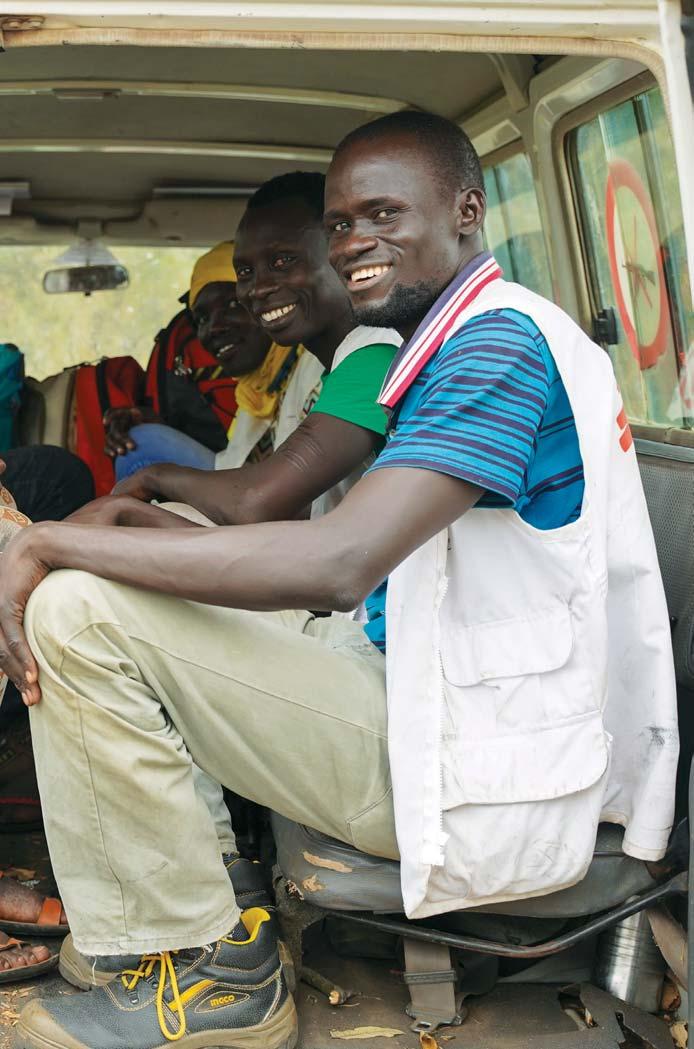
uring the dry season, MSF mobile medical teams follow semi-nomadic cattle-herding communities into the bush, running mobile clinics and treating people for illnesses such as malaria, pneumonia and diarrhoea – the three leading causes of death among children under five in South Sudan.
“During the rainy season, routes become extremely difficult to navigate and our access to these remote communities is hampered,” says deputy medical coordinator Muhammad Ali. “We constantly have to adapt, using cars, motorbikes, boats, and even walking for days if necessary, to reach these people. Our mobile medical teams are willing to do whatever it takes to provide medical care to these isolated communities.”
In many remote areas, medical care is practically non-existent. Less than half of the population of South Sudan live within 5 km of a functioning health facility. Many people struggle to reach even basic
Team members sit in the back of an MSF Land Cruiser during a four-day visit to cattle-herding communities in Labarab.
Few roads exist in this part of South Sudan and many areas are impossible to reach by vehicle during the rainy season.

medical services, sometimes walking for days at a time or crossing borders to neighbouring countries to get the medical care they need.
The families of both farmers and cattle herders live in constant danger of being attacked or killed.
John Oboch is an MSF community health educator who regularly visits herders and their families to conduct health awareness sessions among a group of people he knows very well – as he himself comes from a cattle-herding community.
“I was shot during a raid when I was 15 years old and I lost my arm,” says John. “The fact that I couldn’t properly protect the cattle with a missing arm made me consider getting an education, which I did. Without it, I don’t think I would have ended up working for MSF.”
Along with providing medical care, MSF teams train and supervise members of local communities to administer basic medical care themselves. Community health workers are supplied with medicines and are trained to diagnose and treat various health conditions, referring people with more serious conditions to MSF medical facilities.
SUMMER 2024 | 13
Philip Oloya, an MSF environmental health supervisor, inspects a borehole drilled by MSF in 2022. Half of South Sudanese households rely on surface water as their main water source, which is prone to contamination and risks the spread of waterborne diseases.

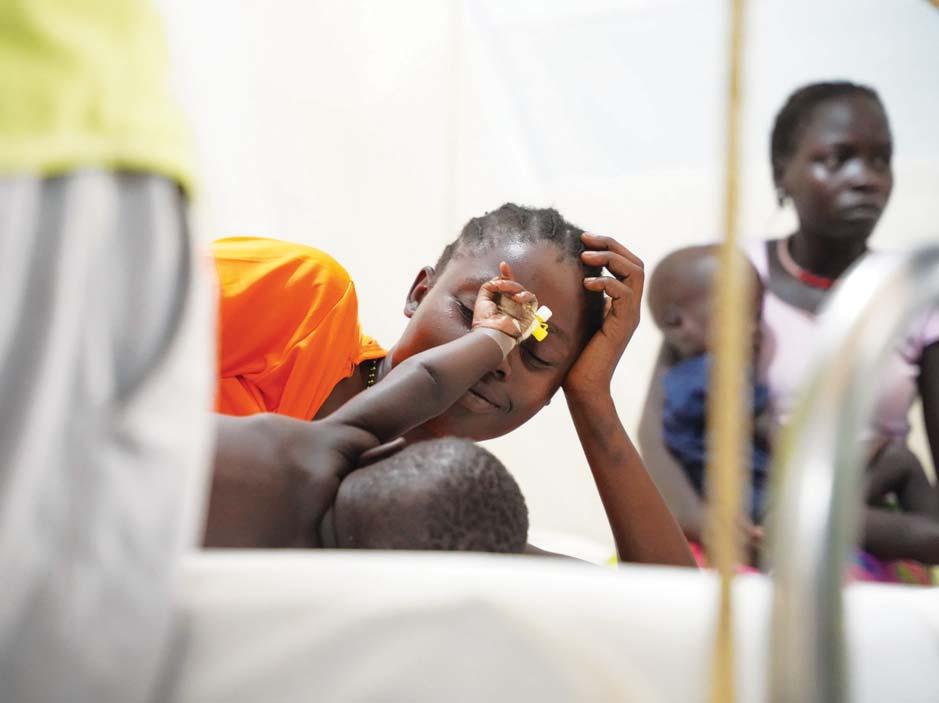
Agut Nyilim plays with her ninemonth-old baby boy while he is treated at Boma clinic, which is supported by MSF. One in 10 children die before reaching their fifth birthday in South Sudan, which also has one of the highest maternal death rates in the world, at 1,223 deaths per 100,000 live births.

14 | DISPATCHES

Cattle-herding communities are often forced to venture deep into the bush to find water and pastures for their cattle to graze on.

Children watch as the MSF team set up a mobile clinic. Malaria, pneumonia and diarrhoea are the leading causes of death among children under five in South Sudan. To make sure that some medical care is available in even the remotest places, MSF has trained community health workers to diagnose symptoms and administer basic treatment and medicines.
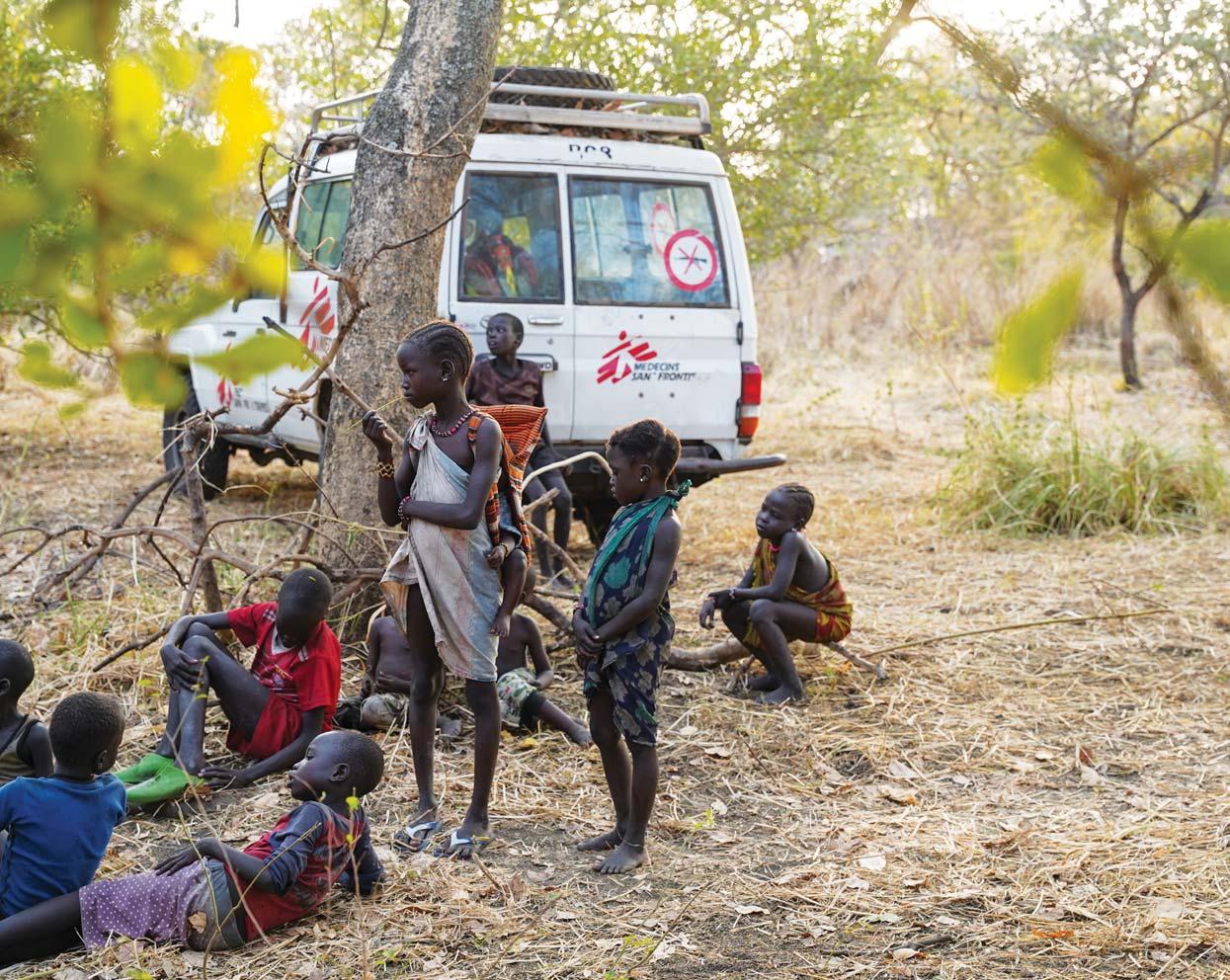
MSF’S UK VOLUNTEERS
Afghanistan: Rachel Crozier, Nurse; Prudence Jarrett, Doctor; Pauline Lynch, Doctor
Bangladesh: Ruth Marshall, Psychiatrist; Orla Murphy, Country coordinator
Benin: Jean Willemyns, Finance/HR manager
Brazil: Laura Guardiola, Nurse
Bulgaria: Jason Dunnett, Finance/HR manager
Central African Republic: Caterina Quagliani, Programme manager
Chad: Emily Hewitt, Health promoter
Democratic Republic of Congo: John Boase, Logistician; Samuel Arnold, Logistician; Sally Pearson, Doctor; Jeremie Postel, Operations manager; Oliver Yerby, Doctor; Ewa Grocholski, Doctor
Ethiopia: Cara Brooks, Head of mission; Ana Moral Garcia, Midwife
Greece: Victoria Roberts, Psychologist
Haiti: Max McCartney, Anaesthetist
India: Nicole Hart, Deputy medical coordinator; Gabriella Bidwell, Doctor; Zareena Mahomed, Doctor
Kenya: Paul Banks, Procurement manager
Lebanon: Milena Beauvallet, Finance and HR manager; Philippa Lowth, Activity manager; Fiona Mitchell, Doctor
Myanmar: Betsie Lewis, Humanitarian affairs officer
Nigeria: Sarah Clowry, Humanitarian affairs manager; Edward Taylor, Head of mission
Pakistan: William de Glanville, Epidemiologist
Palestinian Territories: Laura Williams, Nurse; Stephen Davidson, Nurse; Katharina von Goldacker, Medical activity manager, Chris Hook, Doctor; Gavin Wooldridge, Doctor
Philippines: Emilie Venables, Health promoter
Search and Rescue
Mediterranean: Hanna Yacoub, Cultural mediator
Serbia: Joan Hargan, Medical team leader
Sierra Leone: Charlie Kerr, Logistician
South Sudan: Thomas Taylor, Doctor; Paul Snape, Doctor; Elizabeth Wait, Health promoter; Sofia Vincent, Nurse; Timothy Bean, Logistician; Andrew Burger-Seed, Project coordinator; Stephanie Marriott, Medical coordinator
Sudan: Jennifer Hulse, Doctor; Timothy Hammond, Medical coordinator; Erin Lever, Midwife; Marcus Shelley, Logistician
Syria: Rowena Neville, Medical team leader
Tanzania: Thomas Mitchell, Doctor
Ukraine: Mark Maxwell, Psychologist; Sara Cronin, HR/Finance coordinator
Zimbabwe: Michael Parker, Project coordinator
Cover image: Ita Joice rests with her newborn baby girl, Juan, at the MSF-supported Mundari county hospital in Central Equatoria state, South Sudan. Photograph © Manon Massiat/MSF
MSF community health educator Beatrice Johnson runs a health awareness session for a semi-nomadic community in Labarab, South Sudan. See page 12. Photograph © Manon Massiat/MSF

Médecins Sans Frontières/Doctors Without Borders (MSF) is a leading independent humanitarian organisation for emergency medical aid. In more than 70 countries worldwide, MSF provides relief to the victims of war, natural disasters and epidemics, irrespective of race, religion, gender or political affiliation. MSF was awarded the 1999 Nobel Peace Prize.
TEL 020 7404 6600
ADDRESS Médecins Sans Frontières, Chancery Exchange, 10 Furnival Street, London EC4A 1AB
Charity Registration Number 1026588
ABOUT
Dispatches is written by MSF staff and sent out quarterly to our supporters to keep you informed about our medical work around the world, all of which is funded by you. Dispatches gives our patients and staff a platform to speak out about the conflicts, emergencies and epidemics in which MSF works. It is edited by Marcus Dunk. It costs £0.72 to produce, package and send using the cheapest form of post. It is an important source of income for MSF and raises three times what it costs to produce. We always welcome your feedback. Please contact us using the methods listed, or email: dispatches.uk@london.msf.org
SIGN UP TO EMAIL
Get the latest MSF news delivered to your inbox. Sign up at msf.org.uk/signup
MAKE A DONATION
You can donate by phone, online or by post. If possible please quote your supporter number (located on the top left-hand side of the letter) and name and address.
LEAVING A GIFT IN YOUR WILL
Have you thought of remembering MSF in your will? Any gift is welcome, however large or small. For more information, email legacies@london.msf.org or call us on 020 7404 6600
CHANGING YOUR ADDRESS
Please call 020 7404 6600 or email: uk.fundraising@london.msf.org
CHANGING A REGULAR GIFT
To increase or decrease your regular gift, please call us on 020 7404 6600 or email: uk.fundraising@london.msf.org with your request. Please also get in touch if your bank details have changed.
If you would like to stop receiving communications from us, please contact our Supporter Care team on 020 7404 6600 or email uk.fundraising@london.msf.org and we’ll be happy to help. Thank you for your support.















 An MSF health worker dons full PPE before entering an Ebola treatment centre in the Liberian capital, Monrovia, 30 August 2014. Photograph © Morgana Wingard
An MSF health worker dons full PPE before entering an Ebola treatment centre in the Liberian capital, Monrovia, 30 August 2014. Photograph © Morgana Wingard




 Sia Bintou leaves MSF’s Ebola treatment centre in Guéckédou, Guinea, after recovering from the disease, 19 April 2014. Photograph © Sylvain Cherkaoui/ Cosmos
Sia Bintou leaves MSF’s Ebola treatment centre in Guéckédou, Guinea, after recovering from the disease, 19 April 2014. Photograph © Sylvain Cherkaoui/ Cosmos












































































